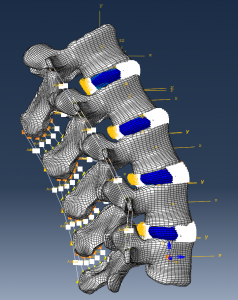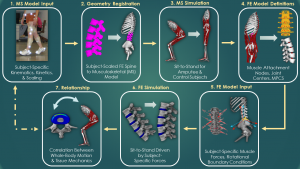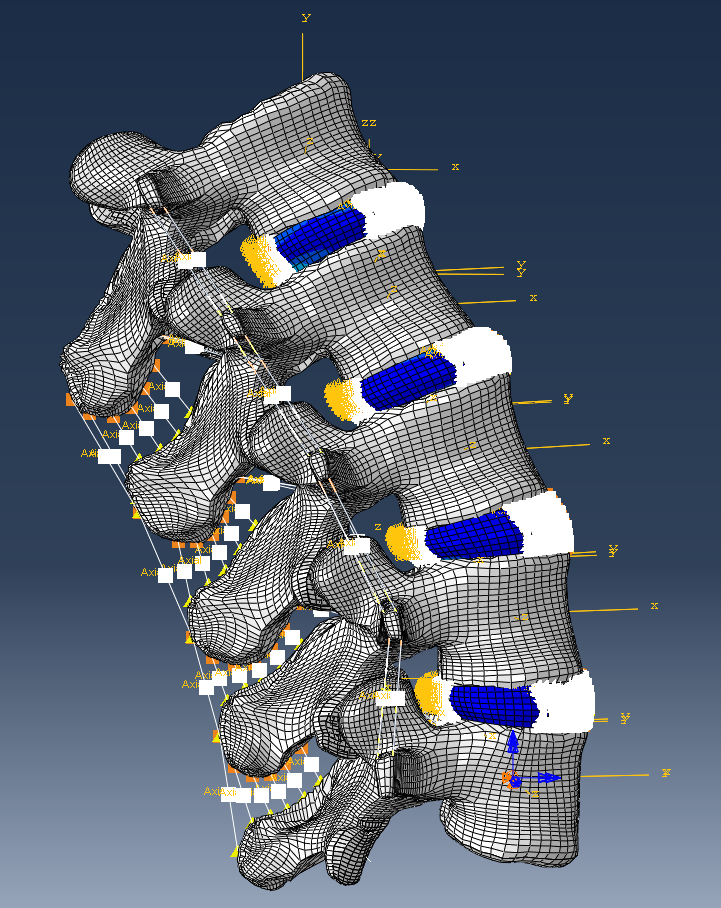‘Project of the Year’ is an annual contest held by Dassault Systèmes where students from around the world are invited to submit projects created with Dassault Systèmes products and software. Winners are chosen by votes from Facebook users and an overall winner is chosen by a jury at Dassault Systèmes headquarters.
This interview with SIMULIA runner-up, Jasmin Honegger, was conducted by SIMULIA Academic Programs Specialist, Katha Sheth. Jasmin used the finite element model in Abaqus for her project, “Predicting the Source of Low Back Pain to Inform Personalized Medicine.”
Please describe why you chose this topic for your project. Why does this workflow need to be analyzed?
It is a challenge to identify and treat sources of low back pain for people with a lower-limb amputation because typically it is characterized as “non-specific.” Over 70% of people with a lower-limb amputation suffer from low back pain and do not receive the specific care they need because the source of pain is not well known. Different types of computational models have been used before to better understand how pain might develop for this population, but no previous study has used finite element modeling (i.e., in Abaqus) to investigate this problem.
Describe how you executed the simulations.

My entire workflow involves the integration of several different platforms. The finite element model (in Abaqus/Standard) consists of 5 rigid lumbar vertebrae with 4 intervertebral discs in-between adjacent vertebrae. The discs each contain an annulus fibrosis modeled using the Holzapfel-Gasser-Ogden hyperelastic material formulation and a nucleus pulposus modeled as a fluid-filled cavity with SFM3D4R elements. The model also includes facet joints modeled with rigid contact surfaces for computational efficiency and 7 spinal ligaments represented with sets of nonlinear tension-only connector elements.
Lumbar spine muscle attachments for 132 muscle fibers were defined as node sets on each vertebra and fixed centers-of-rotation were defined for the intervertebral joints using multi-point constraints (*MPC, BEAM). Experimental kinematic data was collected on people with and without a transtibial amputation in a motion-capture laboratory. The data was used with a rigid-body dynamics model to predict subject-specific muscle force distribution during movement. The Abaqus finite element model was then adapted to each individual subject and the muscle force distribution was implemented using concentrated loads (*CLOAD).
The only boundary condition defined was to hold the L5 vertebra fixed in all degrees of freedom (ENCASTRE). Custom scripts were written to run a total of 5 movement trials for 8 subjects and extract lumbar spine tissue mechanics (S, CFNM, PCAV) from the finite element simulations. Lastly, lumbar spine kinematics (from experimental data) were compared with tissue mechanics (finite element output) to understand the relationship between whole-body dynamic motion and tissue metrics that can lead to pain.
Were there any key technical challenges you faced along the way? How did you solve them?
Ensuring correct model representation (multibody dynamics) and implementation was a significant challenge in working on this project. I learned how one simple definition in an FE model can lead to ripple effects in the simulation results. For example, one key technical challenge was determining how to represent the fixed centers-of-rotation for the intervertebral joints appropriately. My solution process involved trying different types of multi-point constraints between adjacent vertebrae until ultimately determining that beam constraints were the most appropriate. I learned that implementing inappropriate constraints and over-constraining an FE model can lead to other errors such as contact issues.
What were the advantages of using simulation in your project?
One big advantage of using simulation in my project is being able to obtain estimates of biological quantities non-invasively. It is typically difficult or impossible to obtain tissue-level metrics in vivo (within a living human) and computer simulation allows us to make predictions about what is happening within the body without performing surgery or potentially harming an individual.

Why did you choose Abaqus over other simulation products?
The integration of Python scripting within Abaqus is a big reason why I chose Abaqus over other simulation products. The ability to easily automate many simulations and extract results helps to make my research workflow very streamlined. Additionally, knowing that Abaqus is a leading product in FEA simulation means that working with this software will help to prepare me for future jobs.
Do you feel that learning simulation skills in University will provide you with an advantage in your career?
Absolutely. I believe that a person can understand how a simulation process works, but actually working with complex models and understanding how to setup a model, troubleshoot, and obtain meaningful results is key for working in any industry. I feel confident that I can take the simulation skills that I have learned in graduate school and apply them to any project in my career.
What advice do you have for students just beginning to learn simulation tools?
Start with the basics and learn the building blocks. I think it’s much more important to start with simple models and learn about the general workflow for any FEA simulation and key strategies for overcoming common issues before moving onto more complex models and projects.
Is there anything else we should know about this project?
This project was the bulk of my Master’s thesis and I am working on improving and building upon this project currently for my PhD. I am planning to add more geometric detail within the FE model (sacrum and ilia) as well as validate the model for different activities of daily living.
What are your hobbies and interests?
I love rock climbing, hiking, playing music (drums in particular), and just spending time in the mountains. I also enjoy sharing good coffee and beer with friends.
What is your favorite quote?
I have many favorite quotes! But one of them is: “We are what we repeatedly do. Excellence, then, is not an act but a habit.” – Aristotle
To read the full submission of Jasmin’s project, click here.
